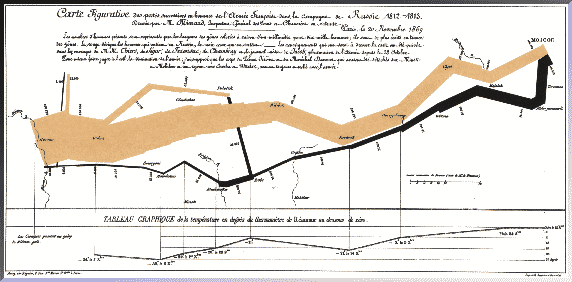I'm having a rough couple of weeks. I won't go all into it, but as a result, I haven't slept much lately. I got about an hour last night, and now feel wide awake, and super stressed. I decided that since I'm up anyway, I might as well be doing schoolwork. While I was reading our blogs, I saw this in
Mark Skalla's:
Perhaps some day in the future I'll be able to take the creative thoughts in my head and accurately display them for others.
This reminded me of something special. Something that seems appropriate for both this blog, and my current emotional state. Something I've loved for a long time. Things are sometimes safer to love.

The above is a map by
Charles Joseph Minard, a civil engineer from France.
This is what it says (translated into English by I-don't-actually-know-who, but I can read just enough French to know that it's accurate):
Map representing the losses over time of French army troops during the Russian campaign, 1812-1813.
Constructed by Charles Joseph Minard,Inspector General of Public Works retired.
Paris, 20 November, 1869.
The number of men present at any given time is represented by the width of the grey line; one mm, represents ten thousand men. Figures are also written besides the lines. Grey designates men moving into Russia; black, for those leaving. Sources for the data are the works of messrs. Thiers, Segur, Fezensac, Chambray and the unpublished diary of Jacob, who became an Army Pharmacist on 28 October. In order to visualize the army's losses more clearly, I have drawn this as if the units under prince Jerome and Marshall Davoust (temporarily separated from the main body to go to Minsk and Mikilow, which then joined up with the main army again,) had stayed with the army throughout.
I know that there are a lot of people who would not consider this art, and I'd like to take this opportunity to scold them. This might be my very favorite creative *thing* that I've ever seen, as far as creative *things* go. I find it heart-stoppingly beautiful. But then, I'm a sucker for tragedy.
Here's what legendary Yale Professor
Edward Tufte famously said about this map:
Probably the best statistical graphic ever drawn, this map by Charles Joseph Minard portrays the losses suffered by Napoleon's army in the Russian campaign of 1812. Beginning at the left on the Polish-Russian border near the Niemen River, the thick band shows the size of the army (422,000 men) as it invaded Russian in June 1812. The width of the band indicates the size of the army at each place on the map. In September, the army reached Moscow, which was by then sacked and deserted, with 100,000 men. The path of Napoleon's retreat from Moscow is depicted by the darker, lower band, which is linked to a temperature scale and dates at the bottom of the chart. It was a bitterly cold winter, and many froze on the march out of Russia. As the graphic shows, the crossing of the Berezina River was a disaster, and the army finally struggled back into Poland with only 10,000 men remaining. Also shown are the movements of auxiliary troops, as they sought to protect the rear and the flank of the advancing army. Minard's graphic tells a rich, coherent story with its multivariate data, far more enlightening than just a single number bouncing along over time. Six variables are plotted: the size of the army, its location on a two-dimensional surface, direction of the army's movement, and temperature on various dates during the retreat from Moscow.
BEST?! EVER?! DRAWN?! That's some strong praise, from a strong source. If you're taking this class, and haven't heard of Edward Tufte, I strongly urge you to follow his link, and get to know his work.
Anyway, back to me and my melodrama. (So educational, you could almost forget it's the internet, right? WRONG.) I really wish I was making this up, but what you are about to read is both humiliating and completely true.
A few years back, I had the pleasure of seeing
the Map show at the Walters. I almost didn't make it due to my near-constant crazy scheduling problems, and got there on the last day. After waiting in line for over two hours(!) to get in, I trolled the halls hungrily. I saw maps by Leonardo da Vinci and J. R. R. Tolkien, among others. You could actually hear the dice bags jingling on the geeks in attendance, honest to G-d. Nerd heaven. It was all lovely, and an historic time was had by all, blah blah blah.
Then, I saw it from across the room.
There's one in every story.
It wasn't even the original drawing, but it
was one of the first edition prints. Like the images here, the "grey" band had been replaced with fragile, hand-burnished gold leaf. The light played on it delicately. It wasn't very large, but my eyes were fixed on it, even from the other side of the expansive gallery. I let out a cry, attracting condemning looks and head-shaking from the other attendees. It was the reason I had come.
I ran, full-tilt ran to it, and began openly and loudly weeping.
Link to a larger image of the map:
http://upload.wikimedia.org/wikipedia/commons/2/29/Minard.png


